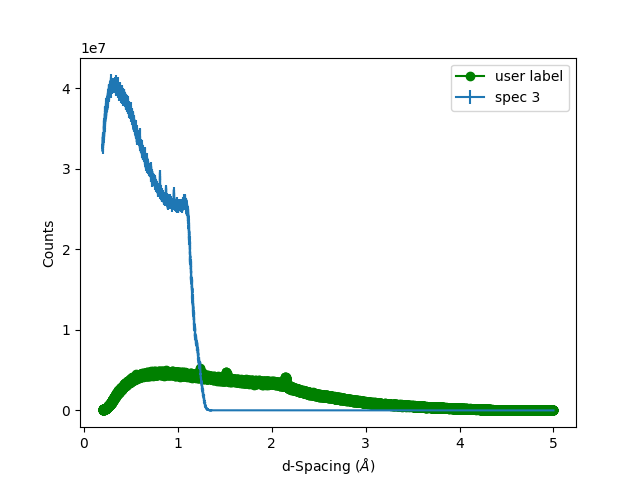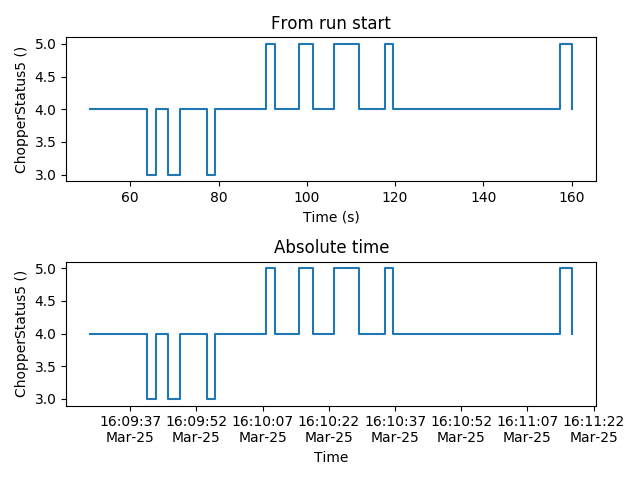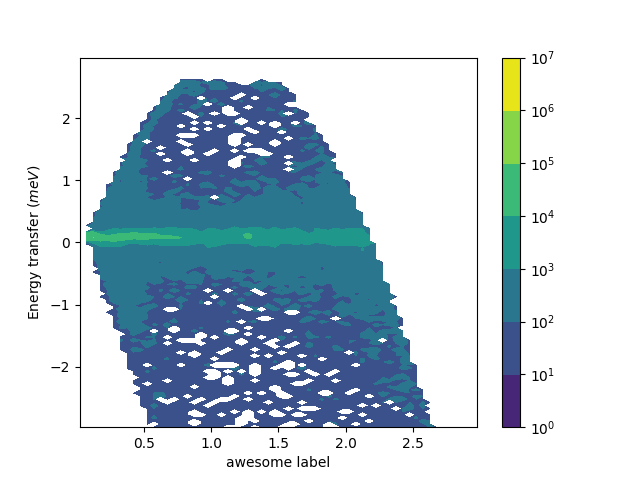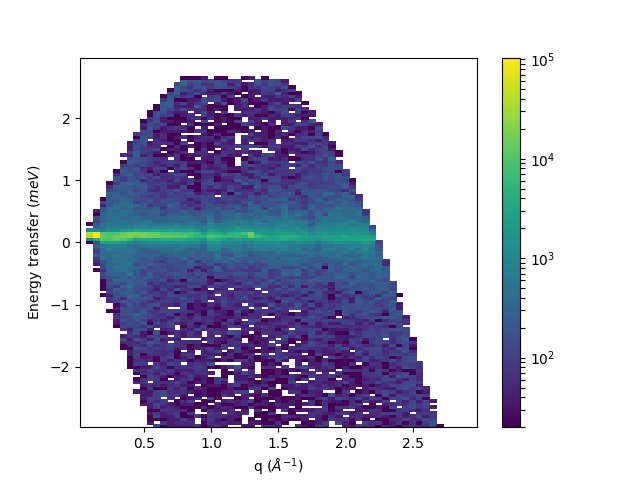\(\renewcommand\AA{\unicode{x212B}}\)
mantid.plots¶The functions in this module are intended to be used with matplotlib’s object oriented abstract program interface (API). matplotlib’s (stateful) functional interface is discouraged by matplotlib. The object oriented API allow for customization as well.
The plotting of a mantid.api.MatrixWorkspace or a
mantid.api.IMDHistoWorkspace can happen in two different ways.
The use of a mantid projection allows most matplotlib-like
experience:
import matplotlib.pyplot as plt
from mantid import plots
#some code here to get a workspace, and x, y, yerr arrays
fig, ax = plt.subplots(subplot_kw={'projection':'mantid'})
ax.errorbar(workspace,'rs',specNum=1) #for workspaces
ax.errorbar(x,y,yerr,'bo') #for arrays
fig.show()
If the mantid projection is not used, the plotting functions take a
matplotlib.axes.Axes and a mantid.api.MatrixWorkspace or
mantid.api.IMDHistoWorkspace, with some keywords that are
specific to Mantid an the type or workspace used. While there are defaults for the
labels, you can easily override them after the initial plotting is
called. A useful reference is matplotlib’s anatomy of a figure.
Note
To run these usage examples please first download the usage data, and add these to your path. In Mantid this is done using Manage User Directories.
All of the examples below can be run with the following imports, but not all are used in all places.
from mantid.simpleapi import mtd, Load, LoadEventNexus, Rebin, ConvertUnits, SofQW, Transpose
from mantid import plots
import matplotlib.pyplot as plt
from matplotlib.colors import LogNorm
First, load some diffraction data and see what the automatic axes will
be using get_axes_labels().
Load(Filename="PG3_733", OutputWorkspace="PG3_733")
print(plots.helperfunctions.get_axes_labels(mtd['PG3_733']))
Which will print the y-label then the labels for all the other
axes as properly escaped for use directly in
matplotlib.axes.Axes.set_xlabel().
('Counts', 'd-Spacing ($\\AA$)', 'Spectrum')
To generate a 1D plots of some spectra with mantid projection:
fig, ax = plt.subplots(subplot_kw={'projection':'mantid'})
ax.plot(mtd['PG3_733'], 'go-', specNum=1, label='user label')
ax.errorbar(mtd['PG3_733'], wkspIndex=2)
ax.legend()
fig.show()
or without:
fig, ax = plt.subplots()
plots.plotfunctions.plot(ax, mtd['PG3_733'], 'go-', specNum=1, label='user label')
plots.plotfunctions.errorbar(ax, mtd['PG3_733'], wkspIndex=2)
ax.legend()
fig.show()

This example demonstrates adding multiple spectra onto a single 1D
plot and overriding some of the default behavior. plot() is a normal
line plot, while errorbar() adds the uncertainties. It should be
warned that every call to one of the plot functions will automatically
annotate the axes with the last one called being the one that takes
effect.
The plot() function also allows
plotting sample logs.
from mantid import plots
import matplotlib.pyplot as plt
w = LoadEventNexus(Filename='CNCS_7860_event.nxs')
fig = plt.figure()
ax1 = fig.add_subplot(211, projection = 'mantid')
ax2 = fig.add_subplot(212, projection = 'mantid')
ax1.plot(w, LogName = 'ChopperStatus5')
ax1.set_title('From run start')
ax2.plot(w, LogName = 'ChopperStatus5', FullTime = True)
ax2.set_title('Absolute time')
fig.tight_layout()
fig.show()

Two common ways to look at 2D plots are contourf() and
pcolormesh(). The difference between these is the
contourf() calculates smooth lines of constant
value, where the pcolormesh() is the actual data
values.
pcolormesh() is similar to pcolor(),
but uses a different mechanism and returns a different object; pcolor returns a PolyCollection
but pcolormesh returns a QuadMesh.
It is much faster, so it is almost always preferred for large arrays.
LoadEventNexus(Filename='CNCS_7860_event.nxs', OutputWorkspace='CNCS_7860_event')
ConvertUnits(InputWorkspace='CNCS_7860_event', OutputWorkspace='CNCS_7860_event', Target='DeltaE', EMode='Direct', EFixed=3)
Rebin(InputWorkspace='CNCS_7860_event', OutputWorkspace='CNCS_7860_event', Params='-3,0.05,3')
SofQW(InputWorkspace='CNCS_7860_event', OutputWorkspace='CNCS_7860_sqw', QAxisBinning='0,0.05,3', EMode='Direct', EFixed=3)
Transpose(InputWorkspace='CNCS_7860_sqw', OutputWorkspace='CNCS_7860_sqw')
fig, ax = plt.subplots(subplot_kw={'projection':'mantid'})
c = ax.contourf(mtd['CNCS_7860_sqw'], norm=LogNorm())
ax.set_xlabel('awesome label')
fig.colorbar(c)
fig.show()

Similarly, showing the actual values with pcolormesh()
fig, ax = plt.subplots(subplot_kw={'projection':'mantid'})
c = ax.pcolormesh(mtd['CNCS_7860_sqw'], norm=LogNorm())
fig.colorbar(c)
fig.show()

A couple of notes about pcolor(),
pcolormesh(),
and pcolorfast():
mantid.api.MatrixWorkspace has unequal bins,
the polygons/meshes will have sides not aligned
with the axes. One can override this behavior by using the
axisaligned keyword, and setting it to Truemantid.api.MatrixWorkspace has different numbers
of bins the above functions will automatically use the
axisaligned behavior (cannot be overridden). contour()
and the like cannot plot these type of workspaces.In addition to the mantid projection, there is also the mantid3d projection for 3d plots.
Can be used much the same as the mantid projection, but by instead specifying mantid3d
when giving the projection:
import matplotlib.pyplot as plt
from mantid import plots
#some code here to get a workspace, and x, y, yerr arrays
fig, ax = plt.subplots(subplot_kw={'projection':'mantid3d'})
ax.plot_wireframe(workspace) #for workspaces
ax.plot_wireframe(x,y,z) #for arrays
fig.show()
Informational
get_axes_labels()1D Plotting
plot() - Plot lines and/or markerserrorbar() - Plot values with errorbarsscatter() - Make a scatter plot2D Plotting
contour() - Draw contours at specified levelscontourf() - Draw contours at calculated levelspcolor() - Draw a pseudocolor plot of a 2-D arraypcolorfast() - Draw a pseudocolor plot of a 2-D arraypcolormesh() - Draw a quadrilateral meshtripcolor() - Draw a pseudocolor plot of an unstructured triangular gridtricontour() - Draw contours at specified levels on an unstructured triangular gridtricontourf() - Draw contours at calculated levels on an unstructured triangular grid3D Plotting
plot() - Draws a line plot in 3D spacescatter() - Draws a scatter plot in 3d spaceplot_wireframe() - Draws a wire frame linking all adjacent data plotsplot_surface() - Draws a surface linking all adjacent data pointscontour() - Draws contour lines at specified levels of the datacontourf() - Draws filled contour lines at specified levels of the datamatplotlib demonstrates the difference between uniform and nonuniform grids well in this example
mantid projection¶mantid.plots.MantidAxes(*args, **kwargs)¶This class defines the mantid projection for 2d plotting. One chooses this projection using:
import matplotlib.pyplot as plt
from mantid import plots
fig, ax = plt.subplots(subplot_kw={'projection':'mantid'})
or:
import matplotlib.pyplot as plt
from mantid import plots
fig = plt.figure()
ax = fig.add_subplot(111,projection='mantid')
The mantid projection allows replacing the array objects with mantid workspaces.
contour(*args, **kwargs)¶If the mantid projection is chosen, it can be
used the same as matplotlib.axes.Axes.contour() for arrays,
or it can be used to plot mantid.api.MatrixWorkspace
or mantid.api.IMDHistoWorkspace. You can have something like:
import matplotlib.pyplot as plt
from mantid import plots
...
fig, ax = plt.subplots(subplot_kw={'projection':'mantid'})
ax.contour(workspace) #for workspaces
ax.contour(x,y,z) #for arrays
fig.show()
For keywords related to workspaces, see plotfunctions.contour()
contourf(*args, **kwargs)¶If the mantid projection is chosen, it can be
used the same as matplotlib.axes.Axes.contourf() for arrays,
or it can be used to plot mantid.api.MatrixWorkspace
or mantid.api.IMDHistoWorkspace. You can have something like:
import matplotlib.pyplot as plt
from mantid import plots
...
fig, ax = plt.subplots(subplot_kw={'projection':'mantid'})
ax.contourf(workspace) #for workspaces
ax.contourf(x,y,z) #for arrays
fig.show()
For keywords related to workspaces, see plotfunctions.contourf()
errorbar(*args, **kwargs)¶If the mantid projection is chosen, it can be
used the same as matplotlib.axes.Axes.errorbar() for arrays,
or it can be used to plot mantid.api.MatrixWorkspace
or mantid.api.IMDHistoWorkspace. You can have something like:
import matplotlib.pyplot as plt
from mantid import plots
...
fig, ax = plt.subplots(subplot_kw={'projection':'mantid'})
ax.errorbar(workspace,'rs',specNum=1) #for workspaces
ax.errorbar(x,y,yerr,'bo') #for arrays
fig.show()
For keywords related to workspaces, see plotfunctions.errorbar()
pcolor(*args, **kwargs)¶If the mantid projection is chosen, it can be
used the same as matplotlib.axes.Axes.pcolor() for arrays,
or it can be used to plot mantid.api.MatrixWorkspace
or mantid.api.IMDHistoWorkspace. You can have something like:
import matplotlib.pyplot as plt
from mantid import plots
...
fig, ax = plt.subplots(subplot_kw={'projection':'mantid'})
ax.pcolor(workspace) #for workspaces
ax.pcolor(x,y,C) #for arrays
fig.show()
For keywords related to workspaces, see plotfunctions.pcolor()
pcolorfast(*args, **kwargs)¶If the mantid projection is chosen, it can be
used the same as matplotlib.axes.Axes.pcolorfast() for arrays,
or it can be used to plot mantid.api.MatrixWorkspace
or mantid.api.IMDHistoWorkspace. You can have something like:
import matpolotlib.pyplot as plt
from mantid import plots
...
fig, ax = plt.subplots(subplot_kw={'projection':'mantid'})
ax.pcolorfast(workspace) #for workspaces
ax.pcolorfast(x,y,C) #for arrays
fig.show()
For keywords related to workspaces, see plotfunctions.pcolorfast()
pcolormesh(*args, **kwargs)¶If the mantid projection is chosen, it can be
used the same as matplotlib.axes.Axes.pcolormesh() for arrays,
or it can be used to plot mantid.api.MatrixWorkspace
or mantid.api.IMDHistoWorkspace. You can have something like:
import matplotlib.pyplot as plt
from mantid import plots
...
fig, ax = plt.subplots(subplot_kw={'projection':'mantid'})
ax.pcolormesh(workspace) #for workspaces
ax.pcolormesh(x,y,C) #for arrays
fig.show()
For keywords related to workspaces, see plotfunctions.pcolormesh()
plot(*args, **kwargs)¶If the mantid projection is chosen, it can be
used the same as matplotlib.axes.Axes.plot() for arrays,
or it can be used to plot mantid.api.MatrixWorkspace
or mantid.api.IMDHistoWorkspace. You can have something like:
import matplotlib.pyplot as plt
from mantid import plots
...
fig, ax = plt.subplots(subplot_kw={'projection':'mantid'})
ax.plot(workspace,'rs',specNum=1) #for workspaces
ax.plot(x,y,'bo') #for arrays
fig.show()
For keywords related to workspaces, see plotfunctions.plot().
scatter(*args, **kwargs)¶If the mantid projection is chosen, it can be
used the same as matplotlib.axes.Axes.scatter() for arrays,
or it can be used to plot mantid.api.MatrixWorkspace
or mantid.api.IMDHistoWorkspace. You can have something like:
import matplotlib.pyplot as plt
from mantid import plots
...
fig, ax = plt.subplots(subplot_kw={'projection':'mantid'})
ax.scatter(workspace,'rs',specNum=1) #for workspaces
ax.scatter(x,y,'bo') #for arrays
fig.show()
For keywords related to workspaces, see plotfunctions.scatter()
tripcolor(*args, **kwargs)¶If the mantid projection is chosen, it can be
used the same as matplotlib.axes.Axes.tripcolor() for arrays,
or it can be used to plot mantid.api.MatrixWorkspace
or mantid.api.IMDHistoWorkspace. You can have something like:
import matplotlib.pyplot as plt
from mantid import plots
...
fig, ax = plt.subplots(subplot_kw={'projection':'mantid'})
ax.tripcolor(workspace) #for workspaces
ax.tripcolor(x,y,C) #for arrays
fig.show()
For keywords related to workspaces, see plotfunctions.tripcolor()
tricontour(*args, **kwargs)¶If the mantid projection is chosen, it can be
used the same as matplotlib.axes.Axes.tricontour() for arrays,
or it can be used to plot mantid.api.MatrixWorkspace
or mantid.api.IMDHistoWorkspace. You can have something like:
import matplotlib.pyplot as plt
from mantid import plots
...
fig, ax = plt.subplots(subplot_kw={'projection':'mantid'})
ax.tricontour(workspace) #for workspaces
ax.tricontour(x,y,z) #for arrays
fig.show()
For keywords related to workspaces, see plotfunctions.tricontour()
tricontourf(*args, **kwargs)¶If the mantid projection is chosen, it can be
used the same as matplotlib.axes.Axes.tricontourf() for arrays,
or it can be used to plot mantid.api.MatrixWorkspace
or mantid.api.IMDHistoWorkspace. You can have something like:
import matplotlib.pyplot as plt
from mantid import plots
...
fig, ax = plt.subplots(subplot_kw={'projection':'mantid'})
ax.tricontourf(workspace) #for workspaces
ax.tricontourf(x,y,z) #for arrays
fig.show()
For keywords related to workspaces, see plotfunctions.tricontourf()
mantid3d projection¶mantid.plots.MantidAxes3D(*args, **kwargs)¶This class defines the mantid3d projection for 3d plotting. One chooses this projection using:
import matplotlib.pyplot as plt
from mantid import plots
fig, ax = plt.subplots(subplot_kw={'projection':'mantid3d'})
or:
import matplotlib.pyplot as plt
from mantid import plots
fig = plt.figure()
ax = fig.add_subplot(111,projection='mantid3d')
The mantid3d projection allows replacing the array objects with mantid workspaces.
contour(*args, **kwargs)¶If the mantid3d projection is chosen, it can be
used the same as matplotlib.axes.Axes3D.contour() for arrays,
or it can be used to plot mantid.api.MatrixWorkspace
or mantid.api.IMDHistoWorkspace. You can have something like:
import matplotlib.pyplot as plt
from mantid import plots
...
fig, ax = plt.subplots(subplot_kw={'projection':'mantid3d'})
ax.contour(workspace) #for workspaces
ax.contour(x,y,z) #for arrays
fig.show()
For keywords related to workspaces, see plotfunctions3D.contour()
contourf(*args, **kwargs)¶If the mantid3d projection is chosen, it can be
used the same as matplotlib.axes.Axes3D.contourf() for arrays,
or it can be used to plot mantid.api.MatrixWorkspace
or mantid.api.IMDHistoWorkspace. You can have something like:
import matplotlib.pyplot as plt
from mantid import plots
...
fig, ax = plt.subplots(subplot_kw={'projection':'mantid3d'})
ax.contourf(workspace) #for workspaces
ax.contourf(x,y,z) #for arrays
fig.show()
For keywords related to workspaces, see plotfunctions3D.contourf()
plot(*args, **kwargs)¶If the mantid3d projection is chosen, it can be
used the same as matplotlib.axes.Axes3D.plot() for arrays,
or it can be used to plot mantid.api.MatrixWorkspace
or mantid.api.IMDHistoWorkspace. You can have something like:
import matplotlib.pyplot as plt
from mantid import plots
...
fig, ax = plt.subplots(subplot_kw={'projection':'mantid3d'})
ax.plot(workspace) #for workspaces
ax.plot(x,y,z) #for arrays
fig.show()
For keywords related to workspaces, see plotfunctions3D.plot3D()
plot_surface(*args, **kwargs)¶If the mantid3d projection is chosen, it can be
used the same as matplotlib.axes.Axes3D.plot_surface() for arrays,
or it can be used to plot mantid.api.MatrixWorkspace
or mantid.api.IMDHistoWorkspace. You can have something like:
import matplotlib.pyplot as plt
from mantid import plots
...
fig, ax = plt.subplots(subplot_kw={'projection':'mantid3d'})
ax.plot_surface(workspace) #for workspaces
ax.plot_surface(x,y,z) #for arrays
fig.show()
For keywords related to workspaces, see plotfunctions3D.plot_surface()
plot_wireframe(*args, **kwargs)¶If the mantid3d projection is chosen, it can be
used the same as matplotlib.axes.Axes3D.plot_wireframe() for arrays,
or it can be used to plot mantid.api.MatrixWorkspace
or mantid.api.IMDHistoWorkspace. You can have something like:
import matplotlib.pyplot as plt
from mantid import plots
...
fig, ax = plt.subplots(subplot_kw={'projection':'mantid3d'})
ax.plot_wireframe(workspace) #for workspaces
ax.plot_wireframe(x,y,z) #for arrays
fig.show()
For keywords related to workspaces, see plotfunctions3D.wireframe()
scatter(*args, **kwargs)¶If the mantid3d projection is chosen, it can be
used the same as matplotlib.axes.Axes3D.scatter() for arrays,
or it can be used to plot mantid.api.MatrixWorkspace
or mantid.api.IMDHistoWorkspace. You can have something like:
import matplotlib.pyplot as plt
from mantid import plots
...
fig, ax = plt.subplots(subplot_kw={'projection':'mantid3d'})
ax.scatter(workspace) #for workspaces
ax.scatter(x,y,z) #for arrays
fig.show()
For keywords related to workspaces, see plotfunctions3D.scatter()
mantid.plots.axesfunctions.plot(axes, workspace, *args, **kwargs)¶Unpack mantid workspace and render it with matplotlib. args and
kwargs are passed to matplotlib.axes.Axes.plot() after special
keyword arguments are removed. This will automatically label the
line according to the spectrum number unless specified otherwise.
| Parameters: |
|
|---|
For matrix workspaces with more than one spectra, either specNum or wkspIndex
needs to be specified. Giving both will generate a RuntimeError. There is no similar
keyword for MDHistoWorkspaces. These type of workspaces have to have exactly one non integrated
dimension
mantid.plots.axesfunctions.errorbar(axes, workspace, *args, **kwargs)¶Unpack mantid workspace and render it with matplotlib. args and
kwargs are passed to matplotlib.axes.Axes.errorbar() after special
keyword arguments are removed. This will automatically label the
line according to the spectrum number unless specified otherwise.
| Parameters: |
|
|---|
For matrix workspaces with more than one spectra, either specNum or wkspIndex
needs to be specified. Giving both will generate a RuntimeError. There is no similar
keyword for MDHistoWorkspaces. These type of workspaces have to have exactly one non integrated
dimension
mantid.plots.axesfunctions.scatter(axes, workspace, *args, **kwargs)¶Unpack mantid workspace and render it with matplotlib. args and
kwargs are passed to matplotlib.axes.Axes.scatter() after special
keyword arguments are removed. This will automatically label the
line according to the spectrum number unless specified otherwise.
| Parameters: |
|
|---|
For matrix workspaces with more than one spectra, either specNum or wkspIndex
needs to be specified. Giving both will generate a RuntimeError. There is no similar
keyword for MDHistoWorkspaces. These type of workspaces have to have exactly one non integrated
dimension
mantid.plots.axesfunctions.contour(axes, workspace, *args, **kwargs)¶Essentially the same as matplotlib.axes.Axes.contour()
but calculates the countour levels. Currently this only works with
workspaces that have a constant number of bins between spectra.
| Parameters: |
|
|---|
mantid.plots.axesfunctions.contourf(axes, workspace, *args, **kwargs)¶Essentially the same as matplotlib.axes.Axes.contourf()
but calculates the countour levels. Currently this only works with
workspaces that have a constant number of bins between spectra.
| Parameters: |
|
|---|
mantid.plots.axesfunctions.pcolor(axes, workspace, *args, **kwargs)¶Essentially the same as matplotlib.axes.Axes.pcolor()
| Parameters: |
|
|---|
mantid.plots.axesfunctions.pcolorfast(axes, workspace, *args, **kwargs)¶Essentially the same as matplotlib.axes.Axes.pcolorfast()
| Parameters: |
|
|---|
mantid.plots.axesfunctions.pcolormesh(axes, workspace, *args, **kwargs)¶Essentially the same as matplotlib.axes.Axes.pcolormesh().
| Parameters: |
|
|---|
mantid.plots.axesfunctions.tripcolor(axes, workspace, *args, **kwargs)¶To be used with non-uniform grids. Currently this only works with workspaces that have a constant number of bins between spectra or with MDHistoWorkspaces.
| Parameters: |
|
|---|
See matplotlib.axes.Axes.tripcolor() for more information.
mantid.plots.axesfunctions.tricontour(axes, workspace, *args, **kwargs)¶Essentially the same as mantid.plots.contour(), but works
for non-uniform grids. Currently this only works with workspaces
that have a constant number of bins between spectra or with
MDHistoWorkspaces.
| Parameters: |
|
|---|
See matplotlib.axes.Axes.tricontour() for more information.
mantid.plots.axesfunctions.tricontourf(axes, workspace, *args, **kwargs)¶Essentially the same as mantid.plots.contourf(), but works
for non-uniform grids. Currently this only works with workspaces
that have a constant number of bins between spectra or with
MDHistoWorkspaces.
| Parameters: |
|
|---|
See matplotlib.axes.Axes.tricontourf() for more information.
mantid.plots.axesfunctions3D.plot(axes, workspace, *args, **kwargs)¶3D plots - line plots
| Parameters: |
|
|---|
mantid.plots.axesfunctions3D.scatter(axes, workspace, *args, **kwargs)¶Scatter plots
| Parameters: |
|
|---|
mantid.plots.axesfunctions3D.plot_wireframe(axes, workspace, *args, **kwargs)¶Wire-frame plot
| Parameters: |
|
|---|
mantid.plots.axesfunctions3D.plot_surface(axes, workspace, *args, **kwargs)¶Surface plots
| Parameters: |
|
|---|
mantid.plots.axesfunctions3D.contour(axes, workspace, *args, **kwargs)¶Contour plots
| Parameters: |
|
|---|
mantid.plots.axesfunctions3D.contourf(axes, workspace, *args, **kwargs)¶Filled Contour plots
| Parameters: |
|
|---|
mantid.plots.datafunctions.get_distribution(workspace, **kwargs)¶Determine whether or not the data is a distribution.
If the workspace is a distribution return true,
else the value in kwargs wins.
Applies to Matrix workspaces only
:param workspace: mantid.api.MatrixWorkspace to extract the data from
mantid.plots.datafunctions.get_normalization(md_workspace, **kwargs)¶Gets the normalization flag of an MDHistoWorkspace. For workspaces derived similar to MSlice/Horace, one needs to average data, the so-called “number of events” normalization.
| Parameters: | md_workspace – mantid.api.IMDHistoWorkspace to extract the data from |
|---|
mantid.plots.datafunctions.points_from_boundaries(input_array)¶The function returns bin centers from bin boundaries
| Parameters: | input_array – a numpy.ndarray of bin boundaries |
|---|
mantid.plots.datafunctions.boundaries_from_points(input_array)¶The function tries to guess bin boundaries from bin centers
| Parameters: | input_array – a numpy.ndarray of bin centers |
|---|
mantid.plots.datafunctions.get_wksp_index_dist_and_label(workspace, axis=<MantidAxType.SPECTRUM: 1>, **kwargs)¶Get workspace index, whether the workspace is a distribution, and label for the spectrum
| Parameters: |
|
|---|
mantid.plots.datafunctions.get_md_data(workspace, normalization, indices=None, withError=False)¶Generic function to extract data from an MDHisto workspace
| Parameters: |
|
|---|
returns a tuple containing bin boundaries for each dimension, the (maybe normalized) signal and error arrays
mantid.plots.datafunctions.get_md_data1d(workspace, normalization, indices=None)¶Function to transform data in an MDHisto workspace with exactly one non-integrated dimension into arrays of bin centers, data, and error, to be used in 1D plots (plot, scatter, errorbar)
mantid.plots.datafunctions.get_md_data2d_bin_bounds(workspace, normalization, indices=None, transpose=False)¶Function to transform data in an MDHisto workspace with exactly two non-integrated dimension into arrays of bin boundaries in each dimension, and data. To be used in 2D plots (pcolor, pcolorfast, pcolormesh)
Note: return coordinates are 1d vectors. Use numpy.meshgrid to generate 2d versions
mantid.plots.datafunctions.get_md_data2d_bin_centers(workspace, normalization, indices=None, transpose=False)¶Function to transform data in an MDHisto workspace with exactly two non-integrated dimension into arrays of bin centers in each dimension, and data. To be used in 2D plots (contour, contourf, tricontour, tricontourf, tripcolor)
Note: return coordinates are 1d vectors. Use numpy.meshgrid to generate 2d versions
mantid.plots.datafunctions.get_spectrum(workspace, wkspIndex, normalize_by_bin_width, withDy=False, withDx=False)¶Extract a single spectrum and process the data into a frequency
| Parameters: |
|
|---|
Note that for workspaces containing bin boundaries, this function will return the bin centers for x. To be used in 1D plots (plot, scatter, errorbar)
mantid.plots.datafunctions.get_matrix_2d_data(workspace, distribution, histogram2D=False, transpose=False)¶Get all data from a Matrix workspace that has the same number of bins in every spectrum. It is used for 2D plots
| Parameters: |
|
|---|
Returns x,y,z 2D arrays
mantid.plots.datafunctions.get_uneven_data(workspace, distribution)¶Function to get data for uneven workspace2Ds, such as that pcolor, pcolorfast, and pcolormesh will plot axis aligned rectangles
| Parameters: |
|
|---|
Returns three lists. Each element in the x list is an array of boundaries for a spectra. Each element in the y list is a 2 element array with the extents of a particular spectra. The z list contains arrays of intensities at bin centers
mantid.plots.datafunctions.get_axes_labels(workspace, indices=None, normalize_by_bin_width=True, use_latex=True)¶Get axis labels from a Workspace2D or an MDHistoWorkspace Returns a tuple. The first element is the quantity label, such as “Intensity” or “Counts”. All other elements in the tuple are labels for axes. Some of them are latex formatted already.
If MDWorkspace then the last element will be the values selected by the indices, to be set as title.
| Parameters: |
|
|---|